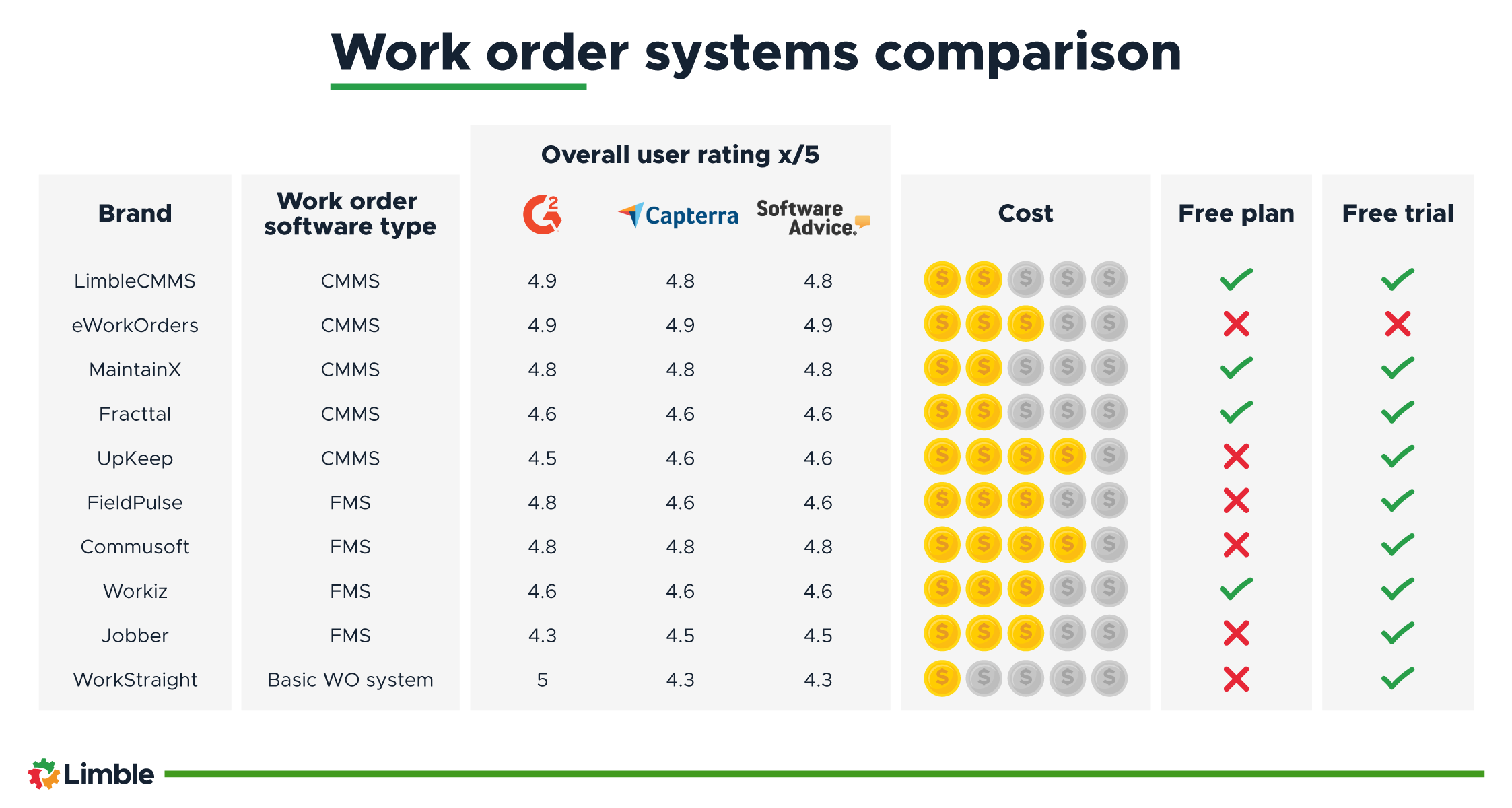
Finding the right maintenance work order system can be a tall task with so many available options. To make the right call on your first try, you need to know what a typical work order system can do, figure out which type of system fits your needs, and understand the key differences between the most popular solutions.
And that’s exactly what we’re going to explore here.
What is a work order system?
A maintenance work order system is a centralized platform designed to help teams manage and track maintenance tasks at their organization from identification to completion. It ensures that all maintenance tasks — preventive maintenance, repairs, inspections, and equipment installations — are systematically organized, assigned, tracked, and closed.
Work order systems are typically used by commercial facilities, manufacturing plants, and property management companies. In other words, any business that manages valuable physical assets or provides on-site services like plumbing or landscaping can benefit from using a work order system.
Here is a list of must-have features for a typical work order system:
- Work order management: This feature allows for the creation, customization, scheduling, and dispatch of work orders. Details such as task description, priority level, required materials, and estimated completion time can be specified on each work order. Tasks can then be assigned to specific team members based on their skills, location, and availability.
- Work progress tracking: Tracking features provide real-time updates on the status of work orders to impacted stakeholders, enhancing transparency and communication.
- Mobile access: Having remote access to the system enables field workers to receive assignments, update work order statuses, and communicate with the team from anywhere.
- Reporting: Using data from work orders generates reports that provide insight into performance, productivity, common issues, and areas for improvement.
- Notifications and alerts: Functions that send automatic notifications about work order updates, due dates, and any other changes that keep relevant parties informed.
- Work request portal: A platform for customers or internal employees to submit work requests, track progress, and communicate with the service team is a critical component of a good maintenance work order system.
More robust work order systems may also include additional features such as the ability to track and manage inventory, helping you maintain adequate stock levels and ensure necessary materials are available when needed.
Which type of maintenance work order system do YOU need?
Work order systems exist on a spectrum.
There are barebones solutions that only allow you to manage work requests and work orders. Then there are robust enterprise management solutions that offer work order modules as just one small part of its extensive feature set. Most fall somewhere in between.
To simplify your decision-making process, we can divide work order systems into three general categories.
1) Barebones work order systems
Basic work order systems are designed to create, assign, track, and close work orders. They provide simple features such as task assignment and status updates, offer a way to submit service requests, and come with basic reporting capabilities.
While they are great for managing work orders, basic WO systems often lack more sophisticated features such as inventory management, preventive maintenance scheduling, or advanced analytics.
They can be a great solution for small businesses that manage a limited number of maintenance tasks on a daily basis and want to move away from spreadsheets and paper forms.
They can also be used by larger teams and organizations that just need a simple system to track incoming service requests and make sure the required work is done on time. This scenario had a very broad range of use cases, from facility management, property management, and general contractors to hospitality, call centers, and even software development.
It is becoming increasingly hard to find solutions that focus exclusively on managing work orders. With time, most software providers add new features, turning their basic WO system into a CMMS.
If you need a simple solution, start your search by looking at WorkStraight.
2) Computerized maintenance management software (CMMS)
CMMS solutions are built to help organizations automate, streamline and simplify all of their maintenance operations. In addition to work order management, a CMMS often includes features like asset management, preventive and predictive maintenance scheduling, inventory control, vendor management, cost tracking, and detailed reporting and analytics.
Having all of your maintenance information in a centralized platform accessed via a mobile device helps maintenance and facility managers skyrocket productivity, cut operational costs, and boost asset performance and longevity.
While you can find industry-specific solutions like fleet management systems, typical CMMS software is flexible and can cover a wide range of different use cases:
- It can be used by businesses of all sizes (although some CMMSs cater to enterprises specifically).
- It tracks and manages all types of physical assets and maintenance work.
- It can be used in virtually any industry. The most popular industries include manufacturing, construction, hospitality, commercial facilities, energy & utilities, and government organizations.
Top-rated CMMS software to consider:
- Limble CMMS
- eWorkOrders
- MaintainX
- Fracttal
- UpKeep
What is the standard we used to create the above list? It’s simple. We looked at the three biggest software review sites — G2, Capterra, and Software Advice — and calculated which solutions offer the best user rating in the CMMS category when averaged across those three sites.
3) Field service management software (FSM)
FSM software is designed to manage and coordinate field operations through a mobile workforce. While it doesn’t have all the broad asset management functions included in a CMMS, it provides tools for scheduling and dispatching tasks, inventory management, customer information management, work order management, billing and invoicing, and more.
The software often comes with a mobile application that allows field technicians to access all necessary information, communicate effectively, and update job status from the field.
Field Service Management Software (FSM) is typically used by businesses that provide on-site services. Here are some common use cases:
- Businesses providing repair and maintenance services, such as HVAC, plumbing, janitorial, or electrical repair services, use FSM to schedule service appointments, assign them to staff, track time and materials used, and handle invoicing and billing.
- Telecommunications and cable companies use FSM software to manage equipment installation, service, and repair at customer locations.
- In the oil and gas industry, FSM software helps schedule and manage maintenance and repairs of complex machinery and equipment in the field.
- Companies doing project-based on-site work like construction and landscaping use FSM software to schedule and dispatch teams, manage materials and equipment, track project progress, and manage costs and billing.
Top-rated FSM software to consider:
- FieldPulse
- Commusoft
- Workiz
- Jobber
What is the standard we used to create the above list? Same as before. We looked at the three biggest software review sites — G2, Capterra, and Software Advice — and calculated which solutions offer the best user rating in the FSM software category when averaged across those three sites.
Comparison of top work order apps in 2023
Choosing the right maintenance software for your organization takes time. You have to evaluate available solutions based on ease of use, available features, and price, among other factors.
To help you streamline this process, below is an infographic that offers a head-to-head comparison of top work order apps in 2023.

A few additional notes:
- Pricing plans are tough to compare as they include different features, limits, number of users, and scaling. Discuss your requirements with the vendors you’re interested in to evaluate any hidden costs.
- All of the software solutions on this list are subscription-based. In other words, you pay a monthly or yearly fee that usually scales with the number of users.
- While some are better for smaller or larger companies, these solutions can generally work with businesses of any size.
- These are all cloud-based platforms, meaning they can be accessed on different mobile devices. Understanding how well each works on your phone will require some testing.
And the winner is?
Different businesses will find different answers to this question.
Take the time to assess your organization’s needs before seeking out a solution to fulfill them. Limble is a robust, highly customizable, and highly rated work order software that is easy to use and also offers a wide range of other asset management functions — making it a good fit for most organizations.
If you would like to learn more about Limble, schedule a personalized product demo or contact our team to learn how Limble can simplify and automate your work order management process.
